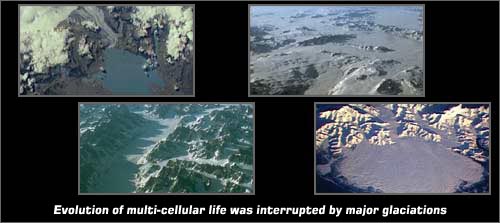Our Environment Contents
1. Evolution
Evolution of multi-cellular life was interrupted by major glaciations.
Successive glaciations, 850, 740 and 650 million years ago, were thought to be caused by increases in the oxygen levels in the atmosphere, causing in turn a relative drop in levels of carbon dioxide and in temperatures. Although early multi-cellular organisms probably caused the demise of the stromatolites by disturbing the microbial mats and grazing on the cyanobacteria, it is plausible that glaciation also had an effect.
When the ice melted 590 million years ago, global sea levels rose, flooding low lying lands and creating shallow seas. The sediments preserved a group of now extinct soft bodied animals: worms and jellyfish-like animals known as Ediacaran Fauna (first discovered in the Ediacaran Hills in South Australia). The interpretation of these animals is highly contentious: some believe that they are an animal kingdom in their own right, while others consider them not to be animals at all, but lichens.

How did glaciation affect the evolution of cellular life?